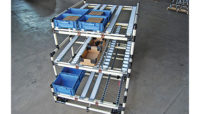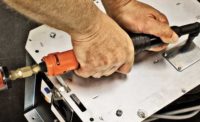From logos to part numbers and bar codes, part marking plays a significant role in today’s manufacturing process. While using a laser to create these marks, safety is a major concern. Marking lasers are available in several styles: CO2, YAG, Diode Pumped, fiber and more. Each style has its own safety concerns and standards that must be considered.
Recently we had a supplier request that we develop a solution for their clutch packs be marked with a barcode and a human readable serial number on the front and rear faces of the clutch pack. We were able to engineer a system that had a robot retrieve the clutch packs from a nested location, present the assembly for marking, and then direct the assembly to a pack-out location.
There were several unique challenges on this project from a safety standpoint such as how to setup the lasers, how will the robot present the assembly to the lasers, and how will the fumes be handled that are created during the marking process?
To ensure safety and precision, two Pulsed Fiber lasers were mounted opposing each other on each end of a stainless steel enclosure. The enclosure was designed and manufactured to ensure the laser markers would receive no direct line of site to the lenses while marking the assembly. The seams and joints of the enclosure were either welded or designed to overlap with the laser lenses extending through the enclosure into its interior. Attachments to the enclosure, such as access holes for wiring and interface brackets, used seal tight fittings and gasket material for proper sealing.
One of the biggest safety concerns was how to seal the enclosure when the robot presented a clutch pack to the lasers. To address this problem, the enclosure required a large opening to allow access for the robot. This application used a two-piece bracket and hood design. The bracket was mounted to the enclosure and surrounded the opening for the robot. The hood mounted to the robot between the end of the arm and the tooling, which is used to seal the enclosure.
While this design enabled the enclosure to be sealed, additional safety measures were needed. By using interlocked safety switches mounted to the enclosure and the hood, the machine is able to verify if the hood is in the proper position over the bracket before actuating the lasers. Additionally, part presence sensors inside the enclosure verify the presence of the clutch pack, which are important in this application due to the configuration of the opposing laser markers.
Another safety concern is the possibility of hazardous fumes and smoke while the lasers are in use. Therefore, proper ventilation of fumes and smoke is essential and factors to consider included the volume that needs to be handled, where will it be evacuated to, and what the hazard level was. For this application, a stand-alone fume extractor was used. This works like a vacuum and connected to the enclosure using a hose. Various types of filters are available for fume extractors including polyester, carbon, and HEPA. The type (or combination) of filter(s) used depends on each application.
When using lasers for part marking, or any other application for that matter, safety considerations need to be thoroughly planned and implemented. Additionally, reviewing the safety regulations and standards that apply to the region and/or country where the system will be implemented is paramount.




